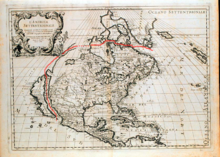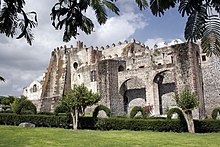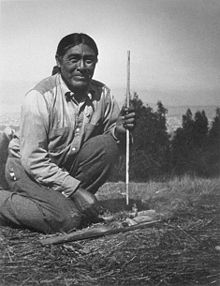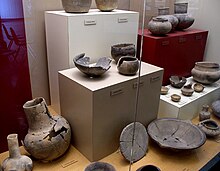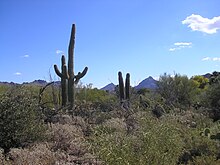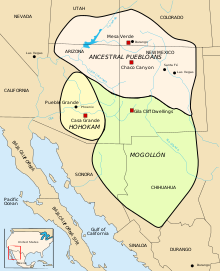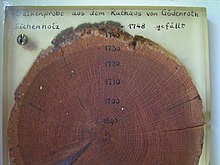Archeology in North America

The Archeology of the Americas is significantly different from that in Europe, where it is traditionally regarded as a branch of anthropology ( science of man; Ethnology ) seen. The reason for this is that there is no written evidence from the time before the conquest by the whites - the Indians knew no writing - and oral traditions are extremely rare. Archaeologists must therefore reconstruct the entire pre-colonial history of North America from the legacies and ruins of the peoples who once populated the continent.
It was not until the 1960s that methods began to emerge that did not rely solely on artefacts as the basis for archaeological research. Attempts were now made to link findings from ethnology with previous research. The ethnologists carried out cultural-ecological research, so they tried to fathom the coexistence of people and to discuss the development of human culture, while traditional archeology was very materially oriented.
Framework
Discovery of North America
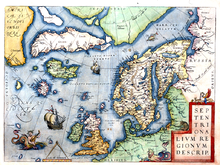
Today, the discovery of America is generally attributed to Christopher Columbus , although it is now certain that Vikings had already reached North America at the time of Erik the Red . But Columbus - although he himself had never set foot on the continent - brought the first written reports from America and the "Indians" to Europe. Columbus had tried to ask the Indians what they believed in and where they once believed they were going. The knowledge about it - although Columbus himself describes it as saying without a use - led to the fact that in 1537 the papal bull Sublimis Deus described Indians as "rational beings with a soul" and thus as "people", although the Bible does not give any references "Redskins" are to be found (as well as, according to the generally accepted view , the colonization of America took place about 11,500 years ago, while the oldest texts in the Bible are "only" about five thousand years old).
Spanish conquests from Mexico

The actual conquest of North America happened after 1492 by the Spaniards from the south. The advance of the English and the French from the east and south-east followed much later.
It is well known that the Spaniards were extremely impudent in their conquest of the New World and left corpses without number in their search for the legendary Eldorado . They were driven by the immeasurable wealth that the indigenous population supposedly possessed - and that the hopelessly indebted Spanish crown urgently needed. The only one who had the courage to stand against the conquerors was Bishop Bartolomé de Las Casas , who in 1552 wrote his "concise report of the devastation of the West Indian lands". He was the only one - as far as is known - who accepted the Indians as a separate people and valued their culture. At least in Central and South America with the Aztecs and Incas the term “culture” was obviously appropriate, with the Indians of North America this would remain controversial for a long time. Las Casas also kept Indian slaves for itself , but treated them humanely. He particularly accuses the Spanish missions , whose main task was to spread the Catholic faith in the New World. In fact, however, the main purpose of baptizing people was to subsequently enslave them and wrest them from their freedom and traditional way of life.
“For forty years they have done nothing else among them, and to this day they do nothing else than to tear them apart, strangle them, torment them, torture them, and torture them through a thousand new and strange torments, of which one was previously never saw, heard or read anything like it, exterminated it from the world in the cruelest way. [It is certain] that in the forty years that have been considered, more than twelve million men, women and children were led to the slaughter in the most nefarious and cruel manner by the aforementioned tyrannical and diabolical process of the Christians. "
These circumstances - the Spaniards were named here as an example, the English and French did not behave any better during their conquest campaigns - meant that no one could ask the Indians about their culture, their religion or their past . Those who had something to say about it were killed or, in the less dire cases, lost the confidence in the whites to tell them about it. And nobody wanted to know anyway.
Most of these atrocities of the first wave of conquest in the 16th century were committed in Central America. North America, and especially the northwest, was still a blank area on the map. Only an ocean was shown on maps from the 17th century at the location of today's states of Washington , Yukon , British Columbia , Northwest Territories and Alaska .
First reports and first advance into North America
The first reports, which were also written down and which today serve as an important source of the time before the European conquest, were formulated by Cabeza de Vaca . He was the first to cross North America from east to west - on foot and in no less than eight years. He was the first to describe the manners and customs of the Indians of North America , under which he had to live all the time in order to survive. Initially as a slave, later he made a name for himself through miraculous healings in the name of the cross , which he kept coming back, which he himself was uncomfortable with.
After de Vaca reached Mexico, an old saga flared up that had already brought much misery to the New World: that of the Seven Cities of Cibola . This legend told of seven legendary cities whose squares and streets were paved with gold and whose doors were set with precious stones. De Vaca himself is considered a very differentiating observer. His reports are accordingly complex and describe the reality of the Indian cultures under which he had to live for eight years very precisely and without prejudice. But everyone just wanted to hear about the mighty kingdoms and the wealth of gold in the north. Finally, his reports on cities, of which he himself had only heard, with multi-storey houses and fortress-like structures, were interpreted as the cities he was looking for (these were "only" the settlements later known as pueblos ). De Vaca was even accused of keeping the real secret of wealth to himself.
Estevanico , who had crossed North America with de Vaca, set out in 1539 with Fray Marcos de Niza to find these legendary cities. The expedition found some of the multi-storey pueblos and was able to conquer them, but they did not find the wealth they were looking for. The only thing there was in abundance in these cities was corn , but for the Spaniards, who were tired and hungry after the long journey, it was almost the same at first.
Expansion of the Spanish territory
To expand their influence in their colonies, the Spaniards used a system later known as the Spanish Missions . Franciscans, Dominicans, Jesuits and Augustinian monks operated mission stations with which they spread the Catholic faith. They baptized the Indians and assigned them to work in the station, which soon became the economic, social and political centers of the conquered areas. There were such stations in all southern and southwestern areas of today's USA: Florida, Texas, New Mexico, Arizona and California. Except for the setback in the so-called Pueblo uprising in New Mexico in 1680, the locals were nowhere able to muster enough strength to stand up to the Spaniards. In many places the Indians were also baptized voluntarily, mainly out of curiosity and to be involved in the trading of the stations. It wasn't until much too late that they realized that this would cause them to lose their freedom. And of course nobody was interested in their culture.
Advance of the Americans to the West
In the 19th century the Americans were advancing from the east against the west. The Indian mattered nothing to them either. Hundreds of thousands of whites, including many who, as gunslingers, did not pay close attention to the limits of the law, invaded the West by the hundreds. Especially in the 1840s and 1850s, as a result of the gold rush in California , many moved to the west. During this time, many of the remaining Indian tribes were literally slaughtered. These butcheries continued until 1868. After that, the California Indians disappeared from the scene. As it turned out later, they had managed to live in secret for almost 40 years, hiding their ways through (the later mystified) sneaking techniques.
The last Indian who was also the first to tell about the customs of his people, the Yana , was Ishi . It was the main attraction of the San Francisco Museum from 1911 until his death in 1916.
Summary
Due to the way North America was conquered, it is easy to see that there were hardly any traditions about the life and culture of the Indian peoples when the past of this continent and its inhabitants actually began to be dealt with towards the end of the 19th century . Another difficulty was that the Indians had not developed any writing system, and there was no visual language, apart from a few cultic figures. In addition, it was recognized early on that many tribes had long since disappeared for unknown reasons and left their cities long before the Europeans arrived. So the only way to find out anything about these races is to analyze their remains. The archeology of North America has to do with prehistory throughout .
History of archeology in North America
First archaeological attempts
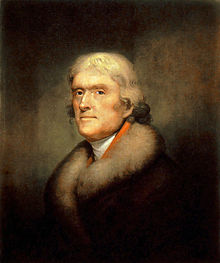
A kind of founder of archeology as a science (and not just looting and grave robbery) is a man who was known for much, but not for his scientific research: Thomas Jefferson , author of the United States Declaration of Independence and later third President of the United States . In 1781 he wrote his Notes on Virginia , which in twenty-three chapters reports in detail on topography, geology, economics and politics, zoology and botany, minerals and marine and on the "indigenous people". In connection with archeology, of course, the latter is of particular interest. Jefferson reports it as "the first attempt at a scientifically considered archaeological dig"
Jefferson is the first to carry out a systematic excavation through a so-called mound , which will be discussed later. He is therefore considered to be the founder of stratigraphy , the theory of layers, i.e. the determination of the (relative) age of objects and bones hidden underground based on their position in relation to one another.
Archeology pioneers
Systematic excavation of mounds and earthworks of the Hopewell and Mississippi cultures began with Ephraim George Squier and Edwin H. Davis digging in the valleys of the Ohio and Mississippi rivers in the 1840s . They published Ancient Monuments of the Mississippi Valley in 1848 as the first volume in the series of the newly formed Smithsonian Institution .
The real beginning of archeology in North America begins with the systematic journey through the west of scientists who would later go down in history and libraries as essential figures in antiquity research. The center of interest is again in the southwest, that dry and sometimes inaccessible area that still has a repulsive effect on most people today. This part of North America was particularly interesting for the archaeologists because they expected and in many ways found the oldest witnesses of the White Culture (namely the Spaniards) as well as the oldest of the Red Culture here. So the southwest of the USA became the Dorado of archaeologists instead of the Dorado of the Spaniards.
Among the most important digging for the past in this area were Adolph F. Bandelier and his indirect successor Alfred Vincent Kidder . Bandelier is considered the pioneer of archeology in the American Southwest . He explored large areas of this now desert-like region on foot with his friend Charles F. Lummis and wrote down very detailed notes in microscopic script. The Bandelier National Monument is named after him.
Both Bandelier and Kidder spent a long time in this area and on countless archaeological sites. Sometimes they dug in a single place over the years, only to have so large amounts of historical material lifted that much of it is still waiting practically unnoticed in the camps of some museums to be evaluated and classified.
Kidder in particular, who later received many honors, made a name for himself by introducing a system into the archeology of North America. He was one of the first to include scientists from other areas of history in his work, such as ethnologists, anthropologists, linguists and geographers. Doctors and pathologists were also called in, because it is sometimes an interesting question of what a certain person died of. Kidder was the first to use the airplane to find places of interest. He sat on the plane with Charles Lindbergh to take photographs, which enabled him to see much that could no longer be recognized from the ground as human work - straight walls and rectangular enclosures of long-crumbled cities.
Earl H. Morris should also be mentioned at this point, who has made a name for himself in particular through the excavation and restoration of the Pueblo Aztec . In it he discovered one of the largest kivas in North America, which has now been restored as a tourist attraction.
New Deal
The work that was organized by the Works Progress Administration , a job creation measure under the New Deal , has an impact to this day . To alleviate unemployment in the Great Depression , US President Franklin Delano Roosevelt launched a variety of programs in which the unemployed were trained and guided by professionals. Archeology was one of the fields of activity almost from the start. In 1933 the excavation of a mound in Marksville , Louisiana was started as a pilot project. Descriptions of well-known archaeological sites in each state followed as part of the state history books produced by the Federal Writers Project . The highlight of the archaeological work as part of the New Deal, however, was the large-scale excavations, mainly in the eastern United States, which not only laid the basis for research into prehistoric Indian cultures, but also created the basis for training professional archaeologists at universities. The Historic Sites Act , passed in 1935, was influential, entrusting the National Park Service with the task of preserving National Historic Sites and thus forming an organizational basis for the profession of archaeologist. Major excavations were Jamestown , the first successful British colony in North America, and the Shell middens on the Green River , Kentucky around Indian Knoll .
The archaeological projects in the New Deal had a significant and long-lasting impact on archeology in the United States. The large number of excavations made the archaeologists more professional. Because untrained excavation workers were used, processes and protocols had to be standardized. The programs also made it possible for the first time to capture the prehistory of the region in its contexts in the southeastern United States, while only a rough overview has existed until now. Last but not least, the Society for American Archeology was founded as a professional association of archaeologists in 1935 as part of professionalization.
Archeology of the East: Atlantic Coast, Ohio, and the Mississippi Basin
Systematic research into prehistory began with digging at so-called mounds . These are found predominantly in the eastern areas of the United States, from Wisconsin to the Gulf of Mexico , but mainly in Ohio . The cultures that shaped these hills were called mound builders .
Mounds
The mounds (roughly translated as mounds , although this term is imprecise and not always appropriate and is therefore not used) are artificial mounds of earth, sometimes of astonishing size, which have been built over the course of time for various purposes. At first they were mainly used as burial mounds, later they were used to build temples. There are also so-called Effigy Mounds , figural hills that mostly take on animal shapes.
In contrast to the pueblos, however, these are mainly found in the east and northeast, east of the Mississippi. In Ohio , in particular, there are thousands of such artificial mounds, the areas of which are close to the size of the Great Pyramid of Cheops . Because this area was settled as early as 1780, the exploration of the mounds is older than that of the pueblos. As mentioned earlier, the first to systematically dig through such a burial mound was Thomas Jefferson . In 1798, a preliminary stage of dendrochronology was used for the first time on a mound: By counting the annual rings of a tree felled on the mound, one could see that it must have been at least 463 years old. Despite these isolated attempts at scientific work on the mounds and despite the 100 years lead that research could have given itself over those in the southwest here, reasonable knowledge remained rare until around 1900 and the writings were grossly incorrect and incomplete.
Of course there were also many "digging" in the mounds, just like with the pueblos, who were not in the least interested in science and knowledge and were only after the treasures. Their methods were correspondingly crude. Since the east was better developed than the south-west in the middle of the 19th century, multitudes of people took part in the treasure hunt, which means that the damage they caused to these unique cultural assets is immense.
The Mound Builder
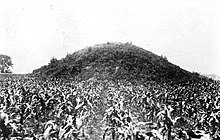

The people who built these strange mounds were initially simply called Mound Builders . After the knowledge about the buildings became better over time, it was recognized that there was not one people at work, but several. As already mentioned, mounds also served various purposes, by no means all of them were for burial.
The first reports of the Mound Builders come from the Spaniards, who penetrated into what is now the United States from the south in the 16th century and sometimes even met the peoples who had built these structures. Of course, they were not interested in the culture, but only in the treasures that could be excavated here. By Hernando de Soto about states: "[He] opened a large temple in the woods, where the chiefs of the country were buried, and stole from him a pearl treasure ..." Many of the grave mounds contained very rich grave goods , what is not only the early explorers, but also many amateur archaeologists, had set aside. The early archaeologists who then moved to the Mound areas from the east did not know or could not read the ancient Spanish scripts, which is why they then, since there were no longer any people to question and accordingly no reasonable explanations for these gigantic structures no longer exist, invented mythical primordial races and other speculations. There were even scholars who thought the structures in the south were Spanish fortifications.
Until the middle of the 19th century, no one was really interested in American prehistory, perhaps apart from the aforementioned Thomas Jefferson , whose Lewis and Clark expedition brought the first knowledge with them from the West. In 1841 George Catlin had to have his notes and paintings made in Indian country printed at his own expense - in London!
After 1900, today's view of the Mound Builder began to emerge. The so-called archaic phase followed the Paleo-Indians , who lived exclusively nomadically . This was followed initially, from around 1000 BC. BC to 700 AD, the time of the burial mounds and then until around 1700 the time of the temple mounds. This purely temporal division (according to Gordon R. Willey ) is vertically divided by the "cultures" - primarily to be understood as social groups. The Adena culture and the Hopewell culture are the two main cultural branches of development of these mound builders.
As often before, the experts disagreed on how to date these cultures. The Adena culture was considered to be older from an early age, as some further developments of certain arts could clearly be made out in the Hopewell culture, but this information was too imprecise for historians. The first knowledge about exact times was only possible with the invention of the radiocarbon method. In contrast to the pueblos, whose years of construction could be determined very precisely using dendrochronology, the matter with the mounds is more difficult. The radiocarbon method provides much less precise information and the construction time of the mounds often extended over several generations. Finally, the question of where the peoples came from and where they will one day move on remains open.
The Adena people (the name is, like almost all of North American archeology, an invention of archaeologists and comes only from the name of a site), who are said to have built the first of these mounds, is characterized by three essential cultural insights: plant cultivation, Ceramic manufacture and organized community work. Their mounds were used for burial, and it is clear from the skeletons that were found or their additions that most of the people buried in a mound came from higher social classes. The cult of the dead must have had a very important meaning, because the type of burial poses some riddles: The bones were colored with red ocher, which of course was only possible after the meat had been removed or rotted. The mounds served as family graves, so they must have been created over generations.
The Adena was followed by the Hopewell, who, due to anatomical differences, were clearly not just descendants of the Adena. It is unclear whether the peoples mixed or whether the Adena were driven out or defeated. The Hopewell graves are much richer than those of the Adena. Their tendency towards expensive and extensive jewelry is also what sets them apart from the Adena in general. In order to procure jewelry and rare materials, they spanned an extensive trading network across North America, from the east coast to the Rocky Mountains and from the Great Lakes to the Gulf of Mexico.
But even this people, which can already be moved close to a high culture, disappeared into the unknown in a relatively short period of time. It disappeared from the map around the fifth century AD. They were now followed by the Temple Mound Builders, i.e. the builders of the Temple Mounds. Their mounds were now only used as an exception for burials, but instead as foundations for (probably) ceremonial temples. Therefore they are comparable to the temple pyramids of the Maya and the Aztecs of South and Central America, even if the latter are made of stone, but these are only made of earth. Today we can only imagine the temples themselves - no archaeologist has ever seen them.
Like the Adena and the Hopewell, the Temple Mound Builders practiced an extensive cult of the dead, as evidenced by various finds. Around 1500 this culture also collapsed, perhaps because the cult of the dead had turned to barbarism - we do not know exactly here either. However, some rituals have survived into historical times as part of the Cherokee , Chocktaw , Chicasaw , Creek and Natchez traditions . The fact that these Indian cultures have suffered badly is mainly due to the influence of the whites, which is reported above.
It was only after the Second World War that the earliest forms of the mound cultures were recognized. Poverty Point in the Mississippi floodplain of Louisiana was known as the location of a mound with an unusual shape and the location of thousands of small loess balls of unknown use as early as the 19th century . But it was only on aerial photographs in 1952 that concentric earth walls and other mounds were recognized, which make the complex the world's largest structure of a hunter-gatherer culture. By means of more recent radiocarbon studies between 2001 and 2006, the facility could be traced back to the 18th to 10th centuries BC. To be dated. It was not until 1981 that Watson Brake was discovered, also in the north of Louisiana , a much smaller system made up of eleven mounds that form a circle around an open space presumably used for ritual purposes. In 1997 Watson Brake was established in the middle of the Archaic Period, 3500-3000 BC. BC, which makes this site the oldest complex mound structure.
Discovery of the Southwest
One of the most important research areas in archeology in North America for the development of the methodology is the so-called southwest of the United States , which does not directly refer to a direction, but to an area. It extends over predominantly desert-like areas in the states of Arizona , New Mexico and parts of Utah , Colorado , Nevada and California in the west and Kansas and Texas in the west.
Pueblos
The most important excavation sites of the archaeologists in the southwest were the so-called pueblos . These villages, in which hundreds or even thousands lived, mostly consisted of adobe walls . The villages were multi-story and all rooms were only accessible through the roof. From the outside you had to climb long ladders to enter them, which gave them a good defense. For archeology it is particularly interesting that the rooms (or their floors) also served as a garbage dump. The remains of many ceramic works can be found in the soil layers of the explored rooms. The ceramic is initially the most important instrument of the age classification of the corresponding layers. In addition, projectile and arrowheads also play a similar role, as the differences between them could also be assigned to epochs. As we shall see, these are particularly important when assessing very old layers, before the ceramic is developed. The central element of the pueblos are the kivas , sacred meeting and ceremonial rooms that were reserved for men.
One of the most important pueblos for archeology and years of excavation of Kidder was the Pecos Pueblo in New Mexico . It was one of the last to be abandoned and crumbled into ruins (Bandelier saw the last people from Pecos). There are even reports of the fall of Pecos because it happened in historical times. Responsible for the decline are, on the one hand, warlike Comanches and , on the other hand, various epidemics . Pecos offered archaeologists rich treasures of various kinds of pottery and human graves. The second important finding in the ruins of Pecos was that before the Pueblo peoples, a people had lived in the area whose craftsmanship was particularly pronounced in basketry . All of their vessels and many utensils were made of wickerwork. That is why these peoples are called the “ basket makers ”. In 1927, at the first so-called Pecos Conference , which he had convened, Kidder presented his age classification of the Indian peoples, which remained valid for decades.
| Pecos classification according to Kidder | Frank HH Roberts |
|---|---|
| Basket Maker I. | --- |
| Basket Maker II | Basket Maker |
| Basket Maker III | Modified Basket Maker |
| Pueblo I | Developmental Pueblo |
| Pueblo II | |
| Pueblo III | Great pueblo |
| Pueblo IV | Regressive Pueblo |
| Pueblo V | Historic Pueblo |
As Kidders order today is more and more of a classification by Frank Roberts Jr. is suppressed, this is also listed.
The excavations of such pueblos, of which there were and in some cases still exist in the southwest, were often quite chaotic, especially in the period up to around 1920. After a site was discovered, it could happen that in a few hours the looting or Wild excavations began, so that a later systematic analysis was no longer possible and many found objects were dragged away forever. Walls were also torn down because one suspected walled-in skeletons behind them, which were often found. After all, the walls made of adobe bricks could very well be used for your own dwellings, similar to how you did with historic buildings of the Old World when they were no longer needed.
Old Spanish reports about a dispute between Spanish expedition members and the Pueblo residents allow certain conclusions to be drawn about the peculiarities of the residents. In 1590, a group of Spaniards, forced to be peaceful because of their hunger, had to seek admission as guests. At first the Indians were peaceful and gave the strangers what they asked for. But when they laid down their weapons and wanted to negotiate a peace treaty, the Indians attacked them, but the Spaniards managed to escape. After the Spaniards returned with reinforcements, the Indians again turned down an offer of peace and showered the strangers with arrows, but gave up very quickly when the Spaniards attacked. In a few days they left the city and left it to the Spanish.
It should be noted that Kidder did not yet know the absolute year numbers in 1927, only their relative reference. The absolute numbers could only be determined a few years later, first by dendrochronology and then by 14 C dating .
| time | Pecos classification according to Kidder | Frank HH Roberts | description |
|---|---|---|---|
| up to approx. 100 BC Chr. | Basket Maker I. | --- | Hypothetical name, late archaic, no finds |
| 100 BC Chr. To 400 AD | Basket Maker II | Basket Maker | Pit houses, caves and rocks depending on the season, cultivation of corn and pumpkin, wickerwork |
| 400 to 700 | Basket Maker III | Modified Basket Maker | Permanent settlements, round earth pit houses, corn, pumpkin and new beans, turkey as a pet; Towards the end: pottery. Replacement of the spear thrower ( Atlatl ) with a bow and arrow |
| 700 to 900 | Pueblo I | Developmental Pueblo | Aboveground huts, weaving and pottery |
| 900 to 1100 | Pueblo II | Developmental Pueblo | Largest extension of the Anasazi tradition; Stone settlements, heyday of the great pueblos, water management and dams |
| 1100 to 1300 | Pueblo III | Great pueblo | Abandonment of many settlements, concentration on a few large pueblos. Settlements in the rocks, roads |
| 1300 to 1700 | Pueblo IV | Regressive Pueblo | Penetration of the Spaniards, emigration from the drought areas towards Rio Grande and Little Colorado, Kiva wall painting |
| 1700 to the present | Pueblo V | Historic Pueblo | European and Spanish influences, the heyday of handicrafts since 1945 |
Cultures of the Southwest

First of all, when describing the cultures of the Southwest, the question arises as to what can be called a “culture”. In practice there is agreement that the Maya and the Aztecs can be described as high cultures, but they lived in Central America. For North America, the picture is more blurred, as many cultural developments took place very slowly and in some cases in parallel, so that the temporal and also the spatial delimitation is hardly possible. There are also no written sources, so that the names of the peoples and their periods of development are often more or less arbitrary inventions of the researchers.
There are also not many things that can be used to determine the development. Basketry and the pottery that replaces it has already been mentioned, and weaving, which the Indians also developed, should also be mentioned. Many other developments that accompanied and shaped the ascent to the great cultures of the early days (Babylon, ancient Egypt) in the old world did not materialize here. The Indians of North America knew neither the wheel nor the wagon, nor the lever or the metal smelting. They had not domesticated any animals or made use of them - with the exception of the turkey , which is known to be happy and voluntary to domesticate itself. In agriculture, they made use of corn and certain types of pumpkin . These are practically the only North American crops.
According to the findings in the pueblos, several ethnic groups were identified, some of which are said to have populated the vast regions of the southwest, partly one after the other, partly simultaneously. However, the division of the periods is subject to constant scientific dispute. The transition from the hunter-gatherer cultures of the Paleo-Indians (which will be discussed later ) is known as the Archaic Period . The transition begins around 8000 BC. The Cochise culture was long considered the origin of the later Pueblo cultures , but that is no longer considered certain today.
One of the better known early cultures of the southwest was the Hohokam . Their name means those who have disappeared (without a trace) . In fact, nothing is known about their whereabouts. They were probably absorbed in other pueblo cultures. Their supposed predecessors were the Cochise, which, as I said, is no longer so clear. A little later than the Hohokam, the neighboring Mogollon emerged. The third important later culture is that of the Anasazi . All three are likely to have influenced each other and later lost their independence through mixing.
The first American
see also : Paleo-Indians
By around 1920 the secrets of the pueblos and the mounds had largely been unraveled. The exact dating measures that were not to be developed until the 1930s and 1940s were still missing, but another, for many even more important question, also remained unanswered: When did the first people colonize North America? Who Was the First American ?
The first find of an alleged Native American was made on October 16, 1869. It was a petrified mummy of a giant . The excavation was a sensation that delighted the masses and the newspapers. However, the discovery of the so-called American Goliath turned out to be a hoax. The find was a deliberately buried plaster statue that went down as the largest scientific forgery in the history of North American archeology.
In 1925, a black cowboy from the Folsom, New Mexico area attracted attention after finding very old bones in a rock wall that he could not identify. The bones had projectile points that were obviously made by human hands. The bones turned out to be those of a bison antiquus figginsi , which had been extinct for around 10,000 years. So the question that arose was whether the projectile tips found belonged to the bison or just happened to be in the same layer. A scientific group led by JD Figgins, director of the Colorado Museum of Natural History, began digging. In 1927, they provided evidence that the projectile points had actually been used to kill the bison because they found projectile points between the costal arches of the fossil bones. This proved that people hunted in this area at least ten thousand years ago.
The Folsom culture was named after the site . The spear points, which turned out to be a characteristic feature of the early inhabitants of North America, are consequently called Folsom points and are among the shortest points that have been found. The tips are also very suitable as a classification feature because they occur in very large numbers all over America. At first archaeologists wondered why these people, whose most important and vital tool was the spear, were so wasteful with their painstakingly made stone tips. Many of the points were also found in the skeletons of the animals, which were probably killed and eaten by humans, so they had not even bothered to reuse the spear points. The solution was provided by Halvor L. Skavlem and his student Alonzo W. Pond around 1930. They tried out the techniques of making stone tools in practice and were able to demonstrate that making a single spearhead only took minutes and not, as is often assumed, several weeks. Even a cleanly cut stone ax could be made in a few hours.
However, no human bones were found at the site. In other finds of animal bones together with Folsom points, human remains were never found, only traces of their work, i.e. notches in bones or burnt bones. In the dangerous hunt that must have been undertaken by the early hunters, it seems astonishing that no human remains have been preserved. Folsom finds were later dated to around 10,000 years before our time using the C-14 method.

In the mountains of Sandia , also in New Mexico , a cave with remains of prehistoric life has been discovered. The excavations began in 1936 under the direction of Frank C. Hibbon . The work turned out to be difficult as it was severely hampered by the amount of dust that was blown up. The first important discovery in the cave was a bone, apparently from a claw. It turned out that the claw was assigned to the giant sloth. Just like the original bison from Folsom, this one has been extinct for at least 10,000 years. Since parts of the skeleton were missing and human tools were found, the assumption arose that the cave had not served the sloth as a shelter, but that humans had dragged parts of the giant sloth into the cave. However, there was no evidence that this animal lived at the same time as humans were using the cave.
For the further systematic excavation, which was now recommended, the problem with the dust had to be solved first, because various students and helpers during the excavation had contracted serious respiratory diseases . After a huge suction machine was installed, the systematic stratigraphic excavation could begin. The top layer of dust and bat excrement of several hundred years was of little interest. Underneath, a thin layer of calcium carbonate was exposed and underneath the so-called Folsom layer, i.e. finds from the Folsom period. Beneath the Folsom layer and under a thick separating layer of yellow ocher was another layer with the remains of human presence and a different shape of spearheads - longer than those of Folsom. So before the Folsom period, there were even earlier residents in this region. These are called the Sandia people according to where they were found . However, no human remains were found during this excavation either, neither bones nor teeth.
Glacial chronology was used to date the new finds precisely (the radiocarbon method was not yet available). The climatic changes during the last ice ages made it possible to investigate the age of the layers based on their moisture content. Kirk Brian, who led this study, came to the conclusion, based on the sequence of layers, that the ocher layer separating Sandia and Folsom in the Sandia Caves must have been about 25,000 years old. This result was a renewed sensation that more than doubled the assumed age of the first inhabitants of North America. Later radiocarbon dates partially confirmed this classification, but today the majority of archaeologists assume that the Sandia peaks are only about 9,000 to 13,000 years old.
The third landmark discovery by early hunters in North America was in Clovis , also in the state of New Mexico. Accordingly, their culture is called the Clovis culture . Their spearheads are significantly longer than those of the Folsom period and also than those of the Sandia period. Their dating is also not clear, but is given to a maximum of about 13,000 years. It is generally believed that the Clovis culture is the oldest widespread nationwide on the American continent, even if many experts still doubt the exact date.
The following classification is accepted to some extent, apart from the dates, which are subject to constant scientific debate:
| period | time | Spearhead | Named after | |
|---|---|---|---|---|
| Clovis | about 12,000-11,000 years ago |  |
Clovis (New Mexico) | Pointed on one side, mainly used for large animal hunting, approx. 9 cm long |
| Sandia | About the same time as Clovis | Sandia Mountains | Fuller on one side, approx. 7.5 cm in length shorter than the Clovis tips | |
| Folsom | For about 11,000 years |  |
Folsom (New Mexico) | Fluted on both sides, at approx. 5 cm significantly shorter and lighter than the other two types |
Evidence of an even older settlement in North America was subsequently found on various occasions. The following list shows some sources. As always, the times, even those made with the C-14 method, which is generally considered to be quite reliable, are subject to considerable fluctuations. Practically every new find starts the debate about the chronology of the indigenous people.
- In 1929, Mark R. Harrington was digging at Gypsum Cave , a cave in Nevada. His dig was special because he was particularly interested in a strange mass that turned out to be feces. Analyzes suggested a large herbivore that was ultimately identified: the giant sloth or its remains. Even parts of his reddish fur were found. The points that were used to kill people here were rhombic and clearly differentiated from the others; they are consequently called Gypsum Points . The special thing about these cave finds was their continuity. The relics of the Paleo Indians were found at the bottom , above those of Basket Maker and the Pueblo Indians as well as the Paiute Indians . At the top, finally, was a can of beans that undoubtedly might have belonged to a modern man, perhaps a cowboy.
- In 1955, huge bones that clearly belonged to extinct animals were found on the San Pedro River . This find showed the problems and inaccuracies of the C-14 method: Different dates of the same fireplace at different universities provided information of 7022 +/- 450 years, 8330 +/- 450 years, 11.180 and 11.290 years. After determining that the first two samples were obviously contaminated, repeat measurements indicated an age between 10,900 and 12,000 years.
- In 1988 archaeologists found Clovis tips made of quartz near East Wenatchee (Washington), which were significantly larger than the usual Clovis tips. They could be dated to 11,250 years ago with a high degree of probability, as they were covered by a layer of volcanic ash that was likely to have originated from the eruption of Glacier Peak , the eruption of which is quite precisely dated.
- Using state-of-the-art technology, human excrement could be found in the Paisley Caves , which could be dated to 14,300 years before our time using the C-14 method. DNA tests could clearly assign the excrement to Native Americans.
- The oldest finds in America to date were made in 2011 in the Buttermilk Creek Complex in Texas . They consist of projectile points and other artifacts that have been clearly identified as the precursors of the Clovis points. This ensures that the Clovis technology was developed in America and not already brought from Asia.
Parallel to the archaeological digs that tried to find the first American, there was always the question of how and when this ancestor had entered the new world. Today there is broad agreement that the first humans must have immigrated to the New World via the then dry Bering Strait at the end of the last Ice Age . The findings from glaciology, which consider such a dry-footed migration through the edge of the Arctic Ocean to be possible up to about 11,500 years ago at most, coincide with the assumed age of the oldest fossil finds of human presence.
Methods
The methods listed were and have become particularly important in the archeology of North America or have been specially developed for it, because many of the possibilities of antiquity research existing in the ancient world, namely the analysis of ancient inscriptions and the interpretation of ancient narratives, cannot be used in the absence of these.
stratigraphy
The most important and oldest method that allowed archaeologists to date was stratigraphy. This teaching assumes that what is thrown away first is on the bottom and what is newest is on top. A chronology can now be reconstructed from this, for example to understand the development of art using found ceramic shards. If you find the same type of broken glass in another place, you can assume that both places were inhabited at the same time. In this way you can also determine which of the two places is the younger or longer inhabited. But the big problem with this method is that you can't give an absolute time statement with it. When were these shards made, when exactly was this pueblo abandoned?
These questions, which are essential for archeology, could only be answered with the invention of three completely new methods that were developed in America and provided answers to precisely the problems that existed here: thermoluminescence dating , the C-14 method and dendrochronology .
Dendrochronology
The oldest of these methods is dendrochronology (tree ring dating) developed by Andrew Ellicott Douglass between 1919 and 1929. The differences in the tree rings of felled trees can be used to determine their age. That was nothing new in itself. Douglass' discovery now consisted in the fact that one could compare the climatically determined growth rings, i.e. the size of the growth rings, of different trees and thus recognize similarities in the courses and thus simultaneity. This enabled very precise dates to be given, but initially still relatively (“this tree was felled exactly nine years after that”). The discovery only became interesting through the creation of so-called tree ring calendars with the help of cross-dating . Various trees and archaeological finds are lined up next to each other in such a way that they result in an uninterrupted row of tree rings based on the present.
The advantages of this method are the relatively low cost of dating and its high accuracy. However, it is also associated with some major disadvantages: First, the entire dating series must be set up, for which as many pieces of wood as possible, for example from excavations or from old houses, are required. However, this is then only valid for a specific climatic region and must be created individually for each climatic region. Also, only certain types of wood are suitable for dendrochronology, mostly oak or pine are used. Of course, this method can only be used to date wood; it is not possible to draw conclusions about the age of ceramics or skeletons. Because wood disintegrates much faster than these materials, dendrochronology can usually only be applied to wood from somewhat preserved ruins.
C-14 method
This method, which has become particularly important for archaeological dating of very old finds, was announced in 1947 by Willard Frank Libby . It is based on the fact that all living beings also take in the radioactive carbon isotope C-14 with their food during their lifetime . After her death, the isotope decays with a half-life of 5730 years. The remaining amount of C-14 in organic material therefore allows conclusions to be drawn about the time of death of an animal or even a plant. The method can therefore be applied to all organic residues, but it has several clear disadvantages: firstly, the measurements are very complex and sometimes imprecise, secondly, very careful attention must be paid to ensure that the samples are not contaminated by newer layers or residues. The archaeologists were also initially dissatisfied that Libby's method of dating irretrievably destroyed the samples.
Thermoluminescence
This relatively new method only works for dating ceramics. This can be used to find out when a ceramic sample was fired. The method, like the C-14 method, is destructive.
interpretation
Each of the methods has its advantages and disadvantages, so the archaeologists have enough work to do to compare the various results and check them for plausibility. The error rate also remains considerable in some cases, for example because contaminated finds are sent to the C-14 laboratory or two samples are accidentally mixed up.
literature
- Terry A. Barnhart: American Antiquities - Revisiting the Origins of American Archeology . University of Nebraska Press 2015, ISBN 978-0-8032-6842-5
- Wolfgang Haberland: American archeology . Scientific Book Society, Darmstadt 1991, ISBN 3-534-07839-X .
Web links
- Archeology in Arctic North America (University of Waterloo)
- Archeology (history of archeology and anthropology in Canada)
Individual evidence
- ↑ Quoted from Ceram, pp. 50f
- ↑ Autobiography, Notes on the State of Virginia, Public and Private Papers, Addresses, Letters , Cambridge University Press, 1984, ISBN 0-521-26344-1
- ↑ Ceram, page 19
- ↑ Our current term red skin for the Indians originated from a mistranslation from Spanish, so it is no less "correct" than the expression "Indian"
- ^ Bernard K. Means: Archeology and the New Deal . In: SAA Archaeological Record , May 2011, page 28
- ^ Gloria Everson: Edward Kennedy, the Federal Writers Project, and Public Archeology. In: SAA Archaeological Record , May 2011, pages 34-37
- ↑ Benjamin C. Pykles: A New Archeology in the New Deal . In: SAA Archaeological Racord , May 2001, pages 38-41
- ^ Bernard K. Means: Shovel Ready - Archeology and Roosevelt's New Deal for America . University of Alabama Press 2013, ISBN 978-0-8173-5718-4 , 240
- ↑ a b Bernard K. Means: Shovel Ready - Archeology and Roosevelt's New Deal for America . University of Alabama Press 2013, ISBN 978-0-8173-5718-4 , 9
- ↑ The time from which written documents are available is generally referred to as historical time .
- ^ Pre-Clovis Breakthrough , April 3, 2008
- ↑ Michael R. Waters, Steven L. Forman et al .: The Buttermilk Creek Complex and the Origins of Clovis at the Debra L. Friedkin Site, Texas (PDF; 990 kB) . In: Science, Volume 331, March 25, 2011, pages 1599-1603
